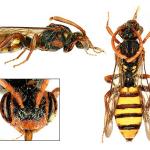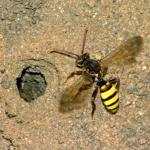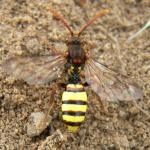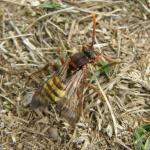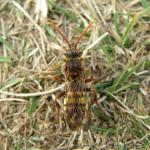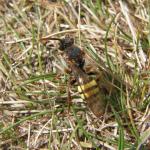Apis infractus HARRIS 1776; Nomada ruficornis var. mirabilis SCHMIEDEKNECHT 1882; Nomada ruficornis var. herrichschaefferi STRAND 1917
A member of the Nomada ruficornis-group, a very large assemblage of about 382 species worldwide (Alexander & Schwarz 1994), of which 17 occur in the British Isles, and another species in the Channel Islands. N. signata is a very close relative of both N. flava and N. panzeri but, in the field, the female N. signata can be distinguished by a combination of uninterrupted transverse yellow bands on gastral tergites 2-4 and a pair of prominent, irregular yellow markings on the propodeum. The male requires closer examination as the band character, which it shares with the female, is also present, though rarely, in N. flava and N. panzeri.
A rare and declining species, although its host Andrena remains a widespread and locally common bee. N. signata formerly occurred sporadically throughout much of southern Britain and the larger Channel Islands, but there are only a few recent records. The species is not known from Scotland and Ireland. The bee is widely distributed in northern and central Europe, its range extending south-eastwards to Turkey.
Listed as Rare (RDB3) in Shirt (1987); revised to Vulnerable (RDB2) by Falk (1991).
To be expected where the host bee is found, which is mainly on open grassland and clearings in broad-leaved woodland.
Univoltine; early April to late May.
A cleptoparasite of Andrena fulva (e.g. Perkins 1919; Chambers 1949; Paxton & Pohl 1999).
Dandelion (Taraxacum sp.), sallow (Salix sp.) and wood spurge (Euphorbia amygdaloides).
None known.
Profile written:
Updated: 22/12/2012


